Abstract
Many epidemiologic reports associate ambient levels of particulate matter (PM) with human mortality and morbidity, particularly in people with preexisting cardiopulmonary disease (e.g., chronic obstructive pulmonary disease, infection, asthma). Because much ambient PM is derived from combustion sources, we tested the hypothesis that the health effects of PM arise from anthropogenic PM that contains bioavailable transition metals. The PM samples studied derived from three emission sources (two oil and one coal fly ash) and four ambient airsheds (St. Louis, MO; Washington; Dusseldorf, Germany; and Ottawa, Canada). PM was administered to rats by intratracheal instillation in equimass or equimetal doses to address directly the influence of PM mass versus metal content on acute lung injury and inflammation. Our results indicated that the lung dose of bioavailable transition metal, not instilled PM mass, was the primary determinant of the acute inflammatory response for both the combustion source and ambient PM samples. Residual oil fly ash, a combustion PM rich in bioavailable metal, was evaluated in a rat model of cardiopulmonary disease (pulmonary vasculitis/hypertension) to ascertain whether the disease state augmented sensitivity to that PM. Significant mortality and enhanced airway responsiveness were observed. Analysis of the lavaged lung fluids suggested that the milieu of the inflamed lung amplified metal-mediated oxidant chemistry to jeopardize the compromised cardiopulmonary system. We propose that soluble metals from PM mediate the array of PM-associated injuries to the cardiopulmonary system of the healthy and at-risk compromised host.
Full text
PDF
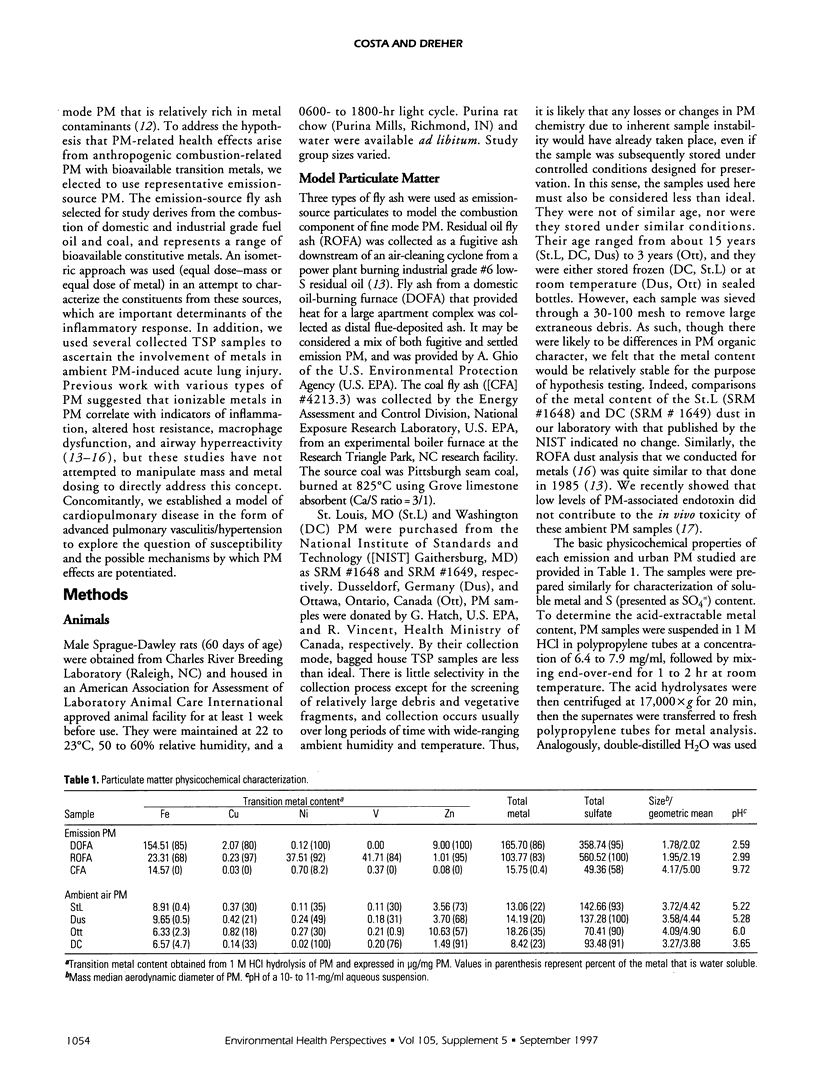
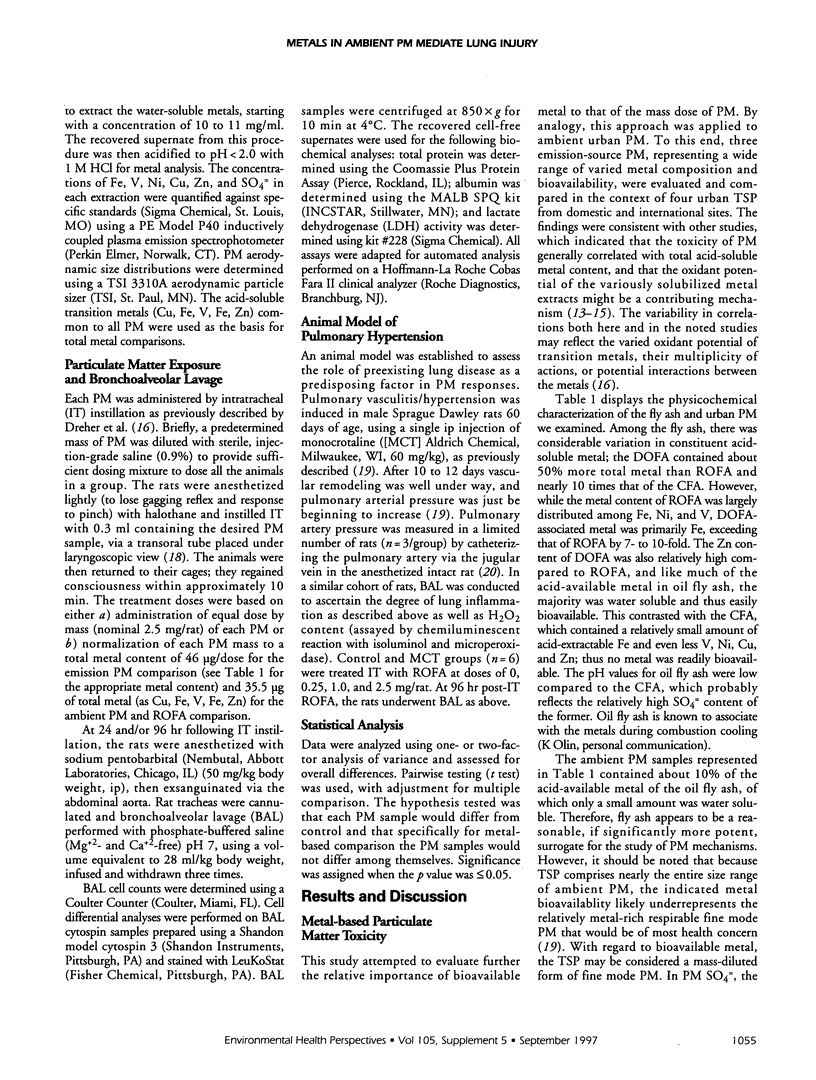
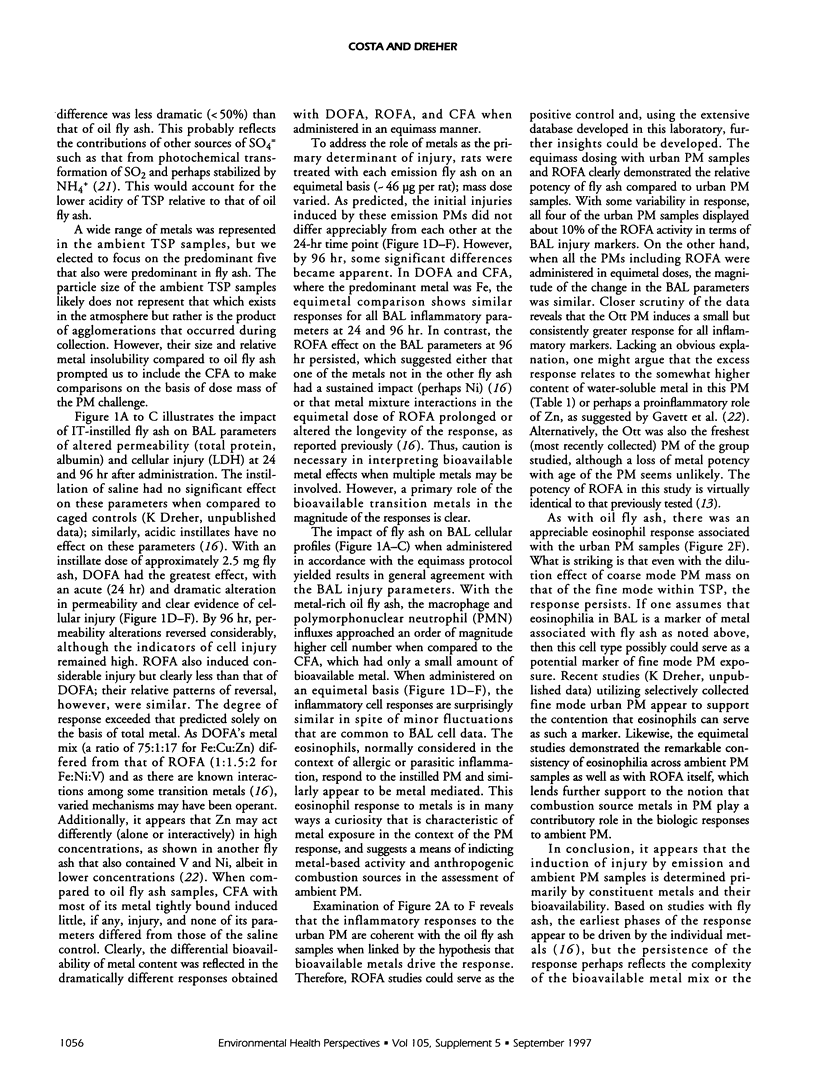
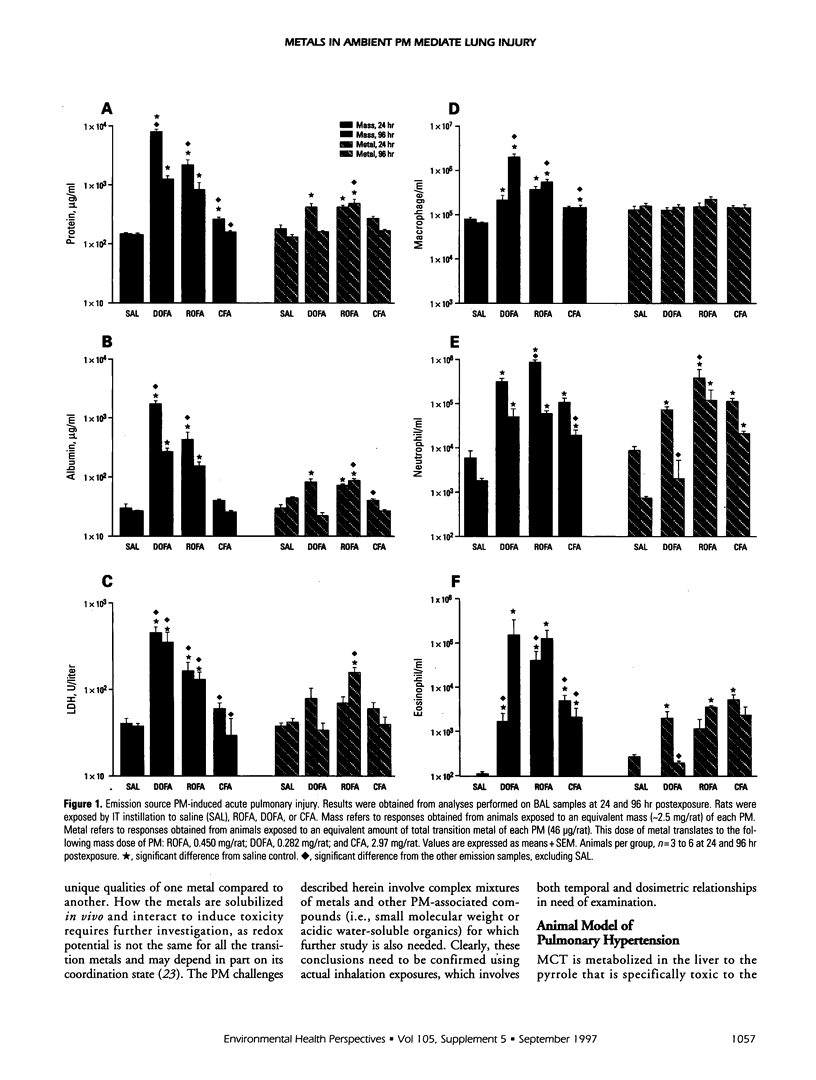


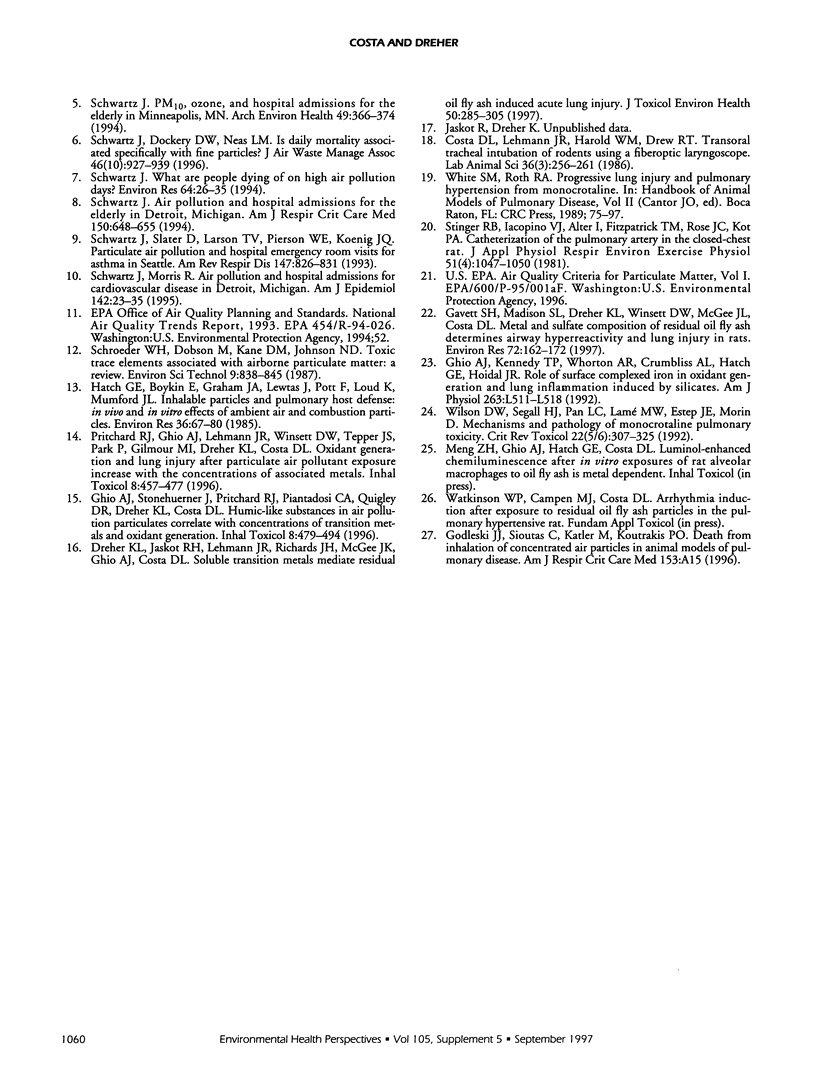
Selected References
These references are in PubMed. This may not be the complete list of references from this article.
- Dockery D. W., Pope C. A., 3rd, Xu X., Spengler J. D., Ware J. H., Fay M. E., Ferris B. G., Jr, Speizer F. E. An association between air pollution and mortality in six U.S. cities. N Engl J Med. 1993 Dec 9;329(24):1753–1759. doi: 10.1056/NEJM199312093292401. [DOI] [PubMed] [Google Scholar]
- Dreher K. L., Jaskot R. H., Lehmann J. R., Richards J. H., McGee J. K., Ghio A. J., Costa D. L. Soluble transition metals mediate residual oil fly ash induced acute lung injury. J Toxicol Environ Health. 1997 Feb 21;50(3):285–305. [PubMed] [Google Scholar]
- Gavett S. H., Madison S. L., Dreher K. L., Winsett D. W., McGee J. K., Costa D. L. Metal and sulfate composition of residual oil fly ash determines airway hyperreactivity and lung injury in rats. Environ Res. 1997 Feb;72(2):162–172. doi: 10.1006/enrs.1997.3732. [DOI] [PubMed] [Google Scholar]
- Ghio A. J., Kennedy T. P., Whorton A. R., Crumbliss A. L., Hatch G. E., Hoidal J. R. Role of surface complexed iron in oxidant generation and lung inflammation induced by silicates. Am J Physiol. 1992 Nov;263(5 Pt 1):L511–L518. doi: 10.1152/ajplung.1992.263.5.L511. [DOI] [PubMed] [Google Scholar]
- Hatch G. E., Boykin E., Graham J. A., Lewtas J., Pott F., Loud K., Mumford J. L. Inhalable particles and pulmonary host defense: in vivo and in vitro effects of ambient air and combustion particles. Environ Res. 1985 Feb;36(1):67–80. doi: 10.1016/0013-9351(85)90008-8. [DOI] [PubMed] [Google Scholar]
- Pope C. A., 3rd, Dockery D. W. Acute health effects of PM10 pollution on symptomatic and asymptomatic children. Am Rev Respir Dis. 1992 May;145(5):1123–1128. doi: 10.1164/ajrccm/145.5.1123. [DOI] [PubMed] [Google Scholar]
- Schwartz J. Air pollution and daily mortality: a review and meta analysis. Environ Res. 1994 Jan;64(1):36–52. doi: 10.1006/enrs.1994.1005. [DOI] [PubMed] [Google Scholar]
- Schwartz J. Air pollution and hospital admissions for the elderly in Detroit, Michigan. Am J Respir Crit Care Med. 1994 Sep;150(3):648–655. doi: 10.1164/ajrccm.150.3.8087333. [DOI] [PubMed] [Google Scholar]
- Schwartz J., Dockery D. W. Increased mortality in Philadelphia associated with daily air pollution concentrations. Am Rev Respir Dis. 1992 Mar;145(3):600–604. doi: 10.1164/ajrccm/145.3.600. [DOI] [PubMed] [Google Scholar]
- Schwartz J., Dockery D. W., Neas L. M. Is daily mortality associated specifically with fine particles? J Air Waste Manag Assoc. 1996 Oct;46(10):927–939. [PubMed] [Google Scholar]
- Schwartz J., Morris R. Air pollution and hospital admissions for cardiovascular disease in Detroit, Michigan. Am J Epidemiol. 1995 Jul 1;142(1):23–35. doi: 10.1093/oxfordjournals.aje.a117541. [DOI] [PubMed] [Google Scholar]
- Schwartz J. PM10, ozone, and hospital admissions for the elderly in Minneapolis-St. Paul, Minnesota. Arch Environ Health. 1994 Sep-Oct;49(5):366–374. doi: 10.1080/00039896.1994.9954989. [DOI] [PubMed] [Google Scholar]
- Schwartz J., Slater D., Larson T. V., Pierson W. E., Koenig J. Q. Particulate air pollution and hospital emergency room visits for asthma in Seattle. Am Rev Respir Dis. 1993 Apr;147(4):826–831. doi: 10.1164/ajrccm/147.4.826. [DOI] [PubMed] [Google Scholar]
- Schwartz J. What are people dying of on high air pollution days? Environ Res. 1994 Jan;64(1):26–35. doi: 10.1006/enrs.1994.1004. [DOI] [PubMed] [Google Scholar]
- Stinger R. B., Iacopino V. J., Alter I., Fitzpatrick T. M., Rose J. C., Kot P. A. Catheterization of the pulmonary artery in the closed-chest rat. J Appl Physiol Respir Environ Exerc Physiol. 1981 Oct;51(4):1047–1050. doi: 10.1152/jappl.1981.51.4.1047. [DOI] [PubMed] [Google Scholar]
- Wilson D. W., Segall H. J., Pan L. C., Lamé M. W., Estep J. E., Morin D. Mechanisms and pathology of monocrotaline pulmonary toxicity. Crit Rev Toxicol. 1992;22(5-6):307–325. doi: 10.3109/10408449209146311. [DOI] [PubMed] [Google Scholar]


